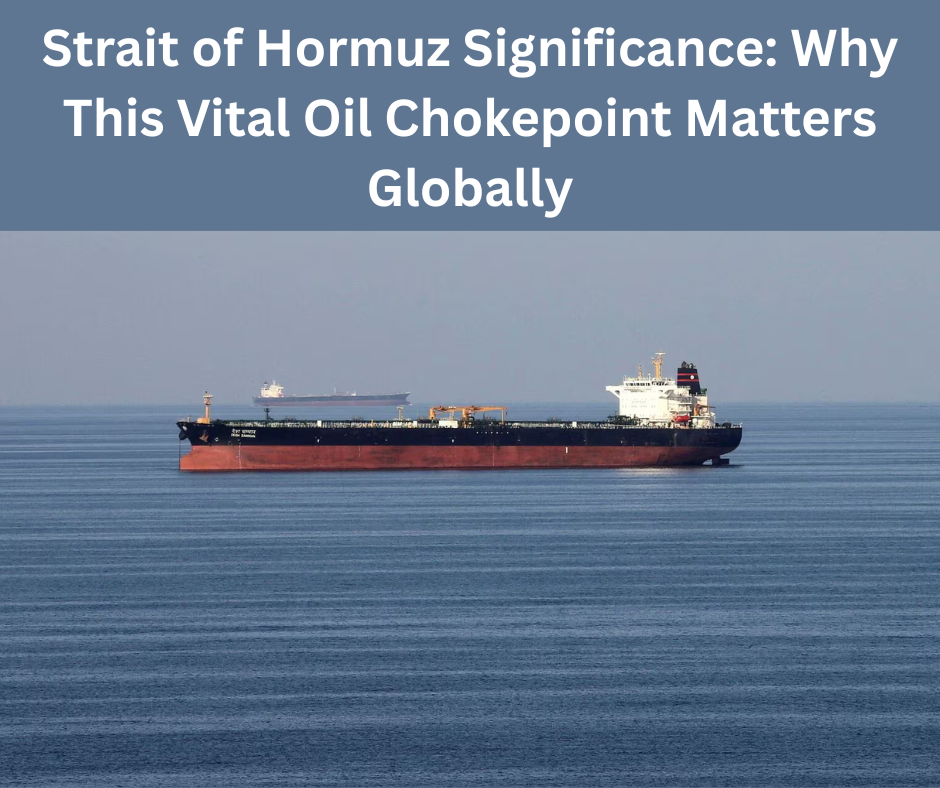Strait of Hormuz Significance: Why This Maritime Chokepoint Holds Global Economic Power
The Strait of Hormuz significance continues to make headlines as escalating tensions in the Middle East threaten the stability of one of the world’s most vital oil routes. Recent military strikes involving Israel, the U.S., and Iran have pushed oil prices higher and ignited fears of disruption in this narrow yet crucial waterway.
Strait of Hormuz Significance in Global Oil Supply
The Strait of Hormuz significance lies in its strategic geographic location between the Persian Gulf and the Gulf of Oman. It is the only sea passage for exporting crude oil from the oil-rich nations of the Persian Gulf to global markets. According to the U.S. Energy Information Administration (EIA), nearly 20 million barrels of oil pass through this strait daily—accounting for about 20% of the world’s total oil consumption.
At its narrowest point, the Strait is just 21 miles wide, but the actual shipping lanes are even tighter, with only two miles of navigable water in each direction. This bottleneck makes it a critical vulnerability for global energy logistics.
Why Investors Watch the Strait of Hormuz
The Strait of Hormuz significance becomes most evident during periods of geopolitical conflict. Following recent airstrikes on Iranian nuclear facilities, global oil benchmarks like Brent crude surged past $80 per barrel for the first time since early 2025. This spike reflects market anxiety over the possibility of Iran retaliating by blocking the Strait.
Analysts suggest that a blockade would drive oil prices toward $100 per barrel. While prices later stabilized, the potential for long-term disruption still looms large.
Iran’s Strategic Leverage and Threats
Iran’s control over the northern coast of the Strait gives it significant geopolitical leverage. Calls from Iranian officials and conservative media outlets to close the waterway have added to global unease. A complete shutdown could cripple economies, especially in Asia, which receives more than 80% of the oil transported through the strait.
According to EIA data, China imports 5.4 million barrels per day via the Strait of Hormuz, while India and South Korea receive 2.1 million and 1.7 million barrels per day, respectively. By contrast, the U.S. and Europe rely far less on this route.
Strait of Hormuz Significance for Asian Economies
Asian economies, particularly China, Japan, and India, have the most to lose if the Strait of Hormuz significance escalates into a full-blown crisis. Japan and Taiwan, for example, depend almost entirely on Middle Eastern oil, and any delay or disruption could cause sharp economic consequences.
China, the largest importer, has urged calm and diplomatic solutions. During a recent press briefing, Chinese Foreign Ministry spokesperson Guo Jiakun emphasized the importance of maintaining peace and open trade routes in the Persian Gulf.
India’s Response to Supply Uncertainty
India’s Petroleum Minister Hardeep Singh Puri assured the public that the country has diversified its oil sources. “A large volume of our supplies no longer depends on the Strait of Hormuz,” he said. “We are prepared to ensure uninterrupted energy supply to our citizens.”
Market Reaction to Strait of Hormuz Developments
Financial markets have already begun reacting to the heightened risks. Stock indexes in Japan, Taiwan, and South Korea dipped, while gold prices rose as investors moved to safer assets. Brent crude and West Texas Intermediate (WTI) also saw a sharp rise in early trading before slightly retreating.
Experts like Takahide Kiuchi from Nomura Research Institute warn that the Japanese economy could suffer more from a Strait closure than from previous trade wars.
U.S. Naval Presence and Strategic Deterrence
The U.S. has bolstered its naval presence in the Persian Gulf to deter any Iranian attempts to close the Strait. According to Vandana Hari, CEO of Vanda Insights, this presence serves as both a deterrent and a rapid response mechanism.
“Iran would gain little and risk much by attempting a full blockade,” she explained. “Any aggressive move could isolate it further and alienate countries that have so far remained neutral.”
Will Oil Prices Spike Again?
While some analysts anticipate continued volatility, others believe the markets are better equipped today to absorb such shocks. Daniel Hynes of ANZ Research points out that spare production capacity among oil exporters can help offset short-term disruptions.
Still, if Iran acts on its threats or if regional conflicts escalate, the Strait of Hormuz significance will dominate oil price dynamics and global economic projections for months to come.
Conclusion: Strait of Hormuz Significance in 2025 and Beyond
The Strait of Hormuz significance remains central to global energy security. Even a remote threat of its closure triggers market panic and prompts swift diplomatic and military responses. As geopolitical tensions persist, the world will continue to watch this narrow waterway with intense scrutiny.
Maintaining the Strait’s stability is not just about oil; it’s about global economic balance. Any interruption here would send ripple effects through supply chains, inflation rates, and geopolitical alliances worldwide.
Understanding the Strait of Hormuz significance is essential for policymakers, investors, and energy analysts aiming to navigate an increasingly uncertain global landscape.
Read more: Israel Iran Airstrike Update

[…] Filmed in Myrtle Beach: Exciting New Productions and Their Storylines Revealed Strait of Hormuz Significance: Why This Vital Oil Chokepoint Matters Globally Israel Iran Airstrike Update: Evin Prison and Basij HQ Targeted in Confirmed Military Action […]
[…] Movies Filmed in Myrtle Beach: Exciting New Productions and Their Storylines Revealed Strait of Hormuz Significance: Why This Vital Oil Chokepoint Matters Globally Israel Iran Airstrike Update: Evin Prison and Basij HQ Targeted in Confirmed Military Action […]